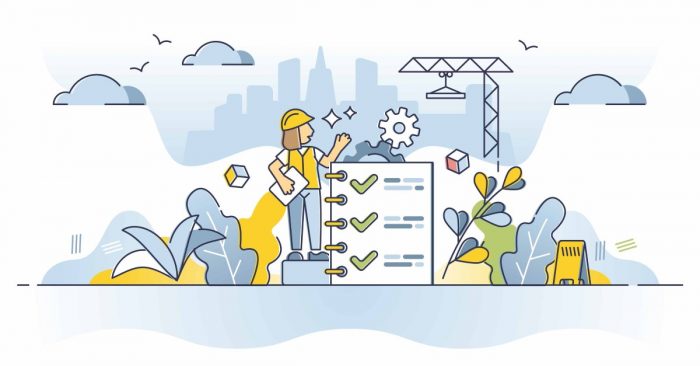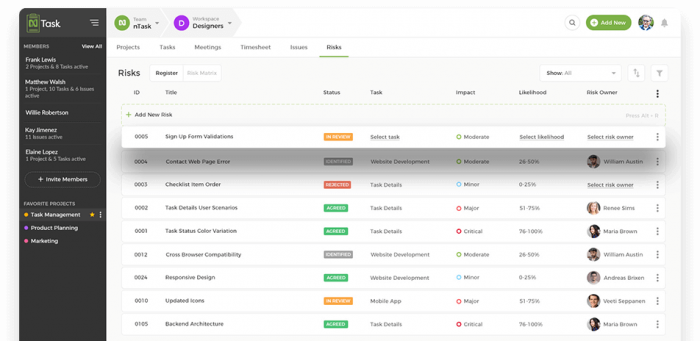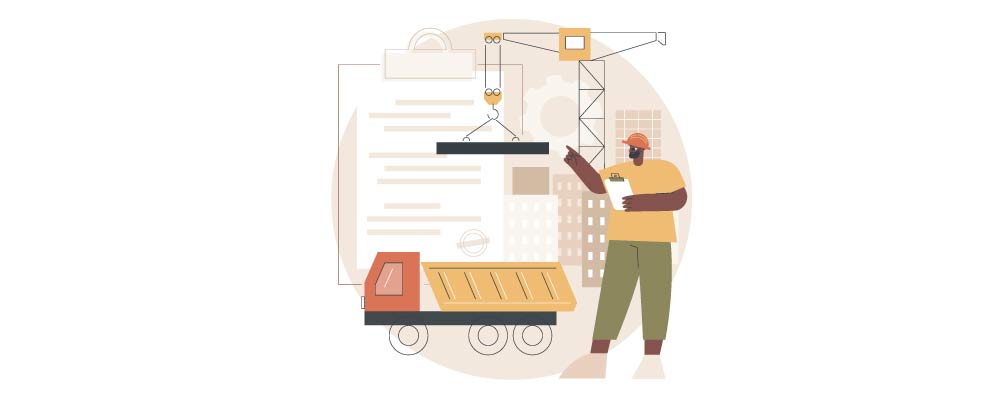Risk management is a crucial element to keep track of when it comes to any sort of project. But when it comes to construction risk management, you need to be extra careful, because a software project going bad might not be as life-threatening as a construction project going bad.
The need for a company to perfect its construction risk management is of absolute importance because of all of the different heavy equipment being used, construction crews working in difficult situations, and other safety hazards that are common in risk management.
Now that we have established how important construction risk management is, let’s take a look at what it is, the benefits associated with it, a list of risks in construction project management, and how you can create an effective construction risk management process for your own endeavors.
What is Construction Risk Management?

This risk management process is a crucial step that a company has to take in order to implement and evaluate different construction procedures without any impact of scope creep and risks.
This risk management process includes detailed planning to create the best risk management plan which helps the project managers associated with the company to identify, evaluate and mitigate different risks associated with their projects, as they come forward.
Many of different project managers around the world use their expertise to mitigate these risks, but we have a better solution for you. A risk management software called nTask.
The software can help you weed out and take care of all of the scope creeps and risks associated with your projects. Check it out.
Coming back to construction risk management, it is a genius plan that is created in the early stages of a construction project that details the risks that might or might not occur in the project development project, and also the solution to resolve them easily.
Let’s now take a look at some of the benefits that construction risk management has to offer.
Featured Readings:
Benefits of Construction Risk Management
Some of the main benefits of construction risk management are:
- Minimizing Project Delays: Construction risk management helps to identify potential risks that could lead to project delays. By mitigating these risks early on, construction projects can be completed within the agreed time frame, avoiding unnecessary delays and associated costs.
- Cost Savings: Effective construction risk management helps to reduce costs associated with construction projects. By identifying potential risks and taking action to mitigate them, construction projects are less likely to experience costly delays, legal disputes, and other unexpected expenses.
- Improved Safety: Construction risk management involves identifying and mitigating safety risks on construction sites. This helps to ensure that workers are safe and that the construction project is completed without any accidents or injuries.
- Enhanced Reputation: Effective construction risk management can help to enhance the reputation of construction companies. By delivering projects on time, within budget, and with minimal risks, construction companies can build a positive reputation in the industry, leading to increased business opportunities.
- Better Project Planning: Construction risk management helps to identify potential risks early on in the planning phase. This enables construction companies to develop a more robust project plan, which can help to reduce the likelihood of risks occurring and improve project outcomes.
Let’s now take a look at the list of risks in construction project management.
5 Different Types of Risks in Construction Management
Here is a list of risks in construction project management that we are going to talk about in this article.
- Safety Risk
- Legal Risk
- Environmental Risk
- Financial Risk
- Project Risk
Let’s take a look at all of them in detail and find out how they can affect our construction processes.
1. Safety Risk
Your construction crew is the most important resource you have at your disposal when it comes to any project because nothing gets done if they don’t show up for work or they are in a hospital somewhere.
This is why safety risk is a very important type of risk and you need to put more focus on this than anything else because if you don’t know the safety risks to your construction crew and don’t make a plan to ensure employee safety, they are going to fall prey to something fatal.
Related:
Top 6 Safety Management Applications to Use in 2024
2. Legal Risk
Managing a construction process consists of a lot of different constraints like cost, time and scope, but among them, there is a more pressing constraint and that is Legal.
These legal constraints include code violations, regulations, and contract term disputes with vendors, clients, and contractors that can put your project in danger or send it off track entirely.
3. Environmental Risk
Construction projects are quite risky, to begin with, and when environmental issues are affecting them, they turn sour to disastrous in a matter of hours.
These environmental issues include earthquakes, strong winds, thunderstorms, and many other forms of natural disasters.
You can’t do much against natural disasters, but what you can do is plan your construction sight accurately, so that you minimize the risks of natural disasters affecting your building.
4. Financial Risk
Finance is a big risk whenever it comes to managing any sort of project, and when there are billions invested in a project, you can’t risk anything. This is why, you as a manager, need to manage your finance accordingly so that you don’t empty out the money train before your project finishes.
5. Project Risk
Project risks are different project management risks that are faced by most of the projects out there. These risks include missing deadlines, poor resource management, and falling behind schedule.
As a manager, you need to be thorough in your evaluation of the project and everything that it basically includes, so that it can be completed in time without any issues.
Let’s now discuss construction risk management in its pride and glory and find out how we can create one for ourselves for our construction projects.
Construction Risk Management
Here are the different steps of the risk management process that you can use to create one for your construction processes.
- Identification
- Assessment
- Mitigation
- Monitoring
- Reporting
Let’s take a look at all of these steps in detail and find out we can use them to create an effective risk management process.
1. Identification
The first step in the risk management process is to identify every possible scope creep or risk that your project is most likely to face in the development process.
As a manager, you need to do the research and you have to talk to your construction crew about any issues that they may have faced in the past. Also, you need to explore all of the data available from past projects that are even vaguely similar to you.
This will give you an idea about how to edit and update your project design so that you side-step most of the scope creeps or risks that may come your way.
2. Assessment
You need to understand that not all risks are the same. You need to assess each and every risk and scope creep associated with the project so that you can direct the team and the right resources to take care of each of the risks without wasting any resources.
To assess the risks, you can use the risk assessment matrix, which makes a visual representation of all of the different risks and how likely they are to affect your project, and how much intensity.
3. Mitigation
The mitigation step is where you implement a proper contingency plan to reduce the impact and likelihood of the risks and scope creeps that haunt your project.
The top priority is obviously those risks that are highly likely to affect the project and the ones with the greatest impact.
To make life easier, these risks should be given an owner, who will identify the risks at hand and also manages the resolution of these risks.
4. Monitoring

The process of monitoring the risks associated with the projects is ongoing. This process is necessary every single day because if you slack off for even a single day, it can prove to be disastrous for your construction process.
The stakeholders should be consulted and consulted, regarding all of these different risks, and to make the process more efficient, you can use risk management software like nTask.
This is a project management software that can also be used for risk management and task management process, which can prove to be helpful in scoping and eliminating all of the different risks and scope creeps from your construction projects.
5. Reporting
You as a manager need to share the risk management process of your construction process with all of the crew members and the stakeholders associated with the project. This information that you are going to share with the stakeholders is going to help you to evaluate its effectiveness.
How? Well, all of them are going to share their reviews regarding the process that will help you to re-evaluate your plan and make changes according to the needs and requirements of the situation at hand.
Why is risk management important in construction?
Construction risk management is particularly important because it involves human lives. You are not only working with material resources but also human resources. The risks involves have to be identified and tracked meticulously to make the project as secure as possible.
In addition, proper risk management in construction shows that the company cares for the well-being of its employees in every possible way. Ultimately, construction risk management improves a company’s reputation in the market and adds to its popularity.
Moreover, with proper risk management accidents can be avoided which means no sudden, unexpected expenditure and more cost savings.
All in all, risk management can help you save big in every way.
Improve Business Productivity through Construction Planning and Scheduling Software
Companies all around the world are always looking for new methods to boost production and efficiency. Using construction planning and scheduling software is one excellent approach to do this. These tools are intended to assist contractors in effectively planning, estimating, and scheduling projects. Organizations can ensure the successful completion of projects by having access to correct data and project plans in one place.
Employing construction planning software can boost overall corporate efficiency in a variety of ways, including:
- Improved communication – Instead of sending an email back and forth between departments or job sites, everyone now has access to real-time information on a construction project. This enhances communication among staff and customers, allowing any issue to be handled swiftly and without delays or ambiguities.
- Accuracy – A construction scheduling program allows you to construct detailed roadmaps with accurate timeframes and milestones that can be tracked at each stage of the process. This removes any uncertainty associated with a task, providing high-quality outcomes every time with minimum change requests from clients.
- Accurate estimates – Generate precise cost forecasts using up-to-date data collected straight from your materials suppliers and subcontractors to prevent problems when it comes time to invoice clients or pay vendors for services provided.
- Increased visibility – Get insight into labour costs and performance by measuring key factors such as overtime hours and resource utilization levels across several workplaces simultaneously, giving you greater control over spending and budgeting decisions throughout the project’s life cycle.
Common Features of Construction Scheduling Software
Companies can enhance their core processes by using the correct software. While choosing a construction scheduling solution, consider the following critical features:
1. Easy-to-Use Interface
The best construction scheduling software should have an easy-to-navigate- interface. The system should be developed with visual elements such as colourful graphs and charts so that users can easily grasp where projects stand without having to be data experts.
2. Task Management & Tracking
Most construction risk management software has task management and tracking features, allowing teams to quickly break down complex projects into separate tasks and allocate them to workers or subcontractors as needed to finish the job more effectively while remaining organized.
3. Resource Planning & Optimization
By tracing resources such as materials, equipment, personnel, and so on, businesses can create automated schedules that account for each resource’s availability as well as other variables such as weather forecasts or customer preferences, and so on, allowing contractors to optimize project timelines before beginning work on site.
4. Time Tracking & Reporting
Good construction software should include tools that allow contractors to accurately monitor worker activity as well as report on productivity over time intervals such as days/weeks/months, allowing managers to make informed decisions about staffing needs or potential areas of improvement quickly and reliably.
5. Integrations
In addition to visualization and planning features, many modern construction scheduling programs include integrations that allow them to communicate directly with other video conferencing platforms and document management systems used within organizations, such as Slack or Dropbox, allowing for greater flexibility in quickly sharing information among different departments.
How to manage risks for construction businesses?
Managing risks is a crucial part of running a successful construction business. Construction projects are inherently risky, and the failure to manage those risks can result in significant financial losses, project delays, and even legal disputes. Here are some key steps to manage risks for construction businesses:
Identification of Risk:
The first step is to identify potential risks that could impact the construction project. These risks could include safety hazards, weather conditions, delays, legal disputes, etc.
Prioritize the Risk:
Once you have identified potential risks, prioritize them based on the likelihood of occurrence and the potential impact on the project.
Make Your Risk Response Strategy:
Develop a risk response strategy for each identified risk. These strategies could include avoidance, transfer, mitigation, or acceptance.
- Risk Avoidance: Risk avoidance involves taking steps to avoid the risk altogether. For example, if there is a risk of flooding, you could avoid building in a flood-prone area.
- Risk Transfer: Risk transfer involves transferring the risk to another party, such as an insurance company or a subcontractor.
- Risk Mitigation: Risk mitigation involves taking steps to reduce the likelihood or impact of the risk. For example, if there is a risk of worker injury, you could implement safety protocols and provide training.
- Risk Acceptance: Risk acceptance involves accepting the risk and preparing to deal with it if it occurs.
Implement Risk Management Plan:
Implement the risk management plan by incorporating risk mitigation strategies into project planning and execution.
Include Your Team in the Whole Process:
Involve all relevant team members in the risk management process, including project managers, subcontractors, and workers. Ensure that everyone is aware of the identified risks and the strategies to mitigate them.
Contingency Plan and Repeat:
Develop a contingency plan to address any unforeseen risks that may occur during the construction process. Review and repeat the risk management process regularly to ensure that new risks are identified and managed effectively.
Conclusion
This was our short guide on construction risk management highlighting the benefits, types, and the risk management process that goes with your construction projects. If you think that we missed something, then don’t be a stranger and let us know as soon as possible.
More Readings:

